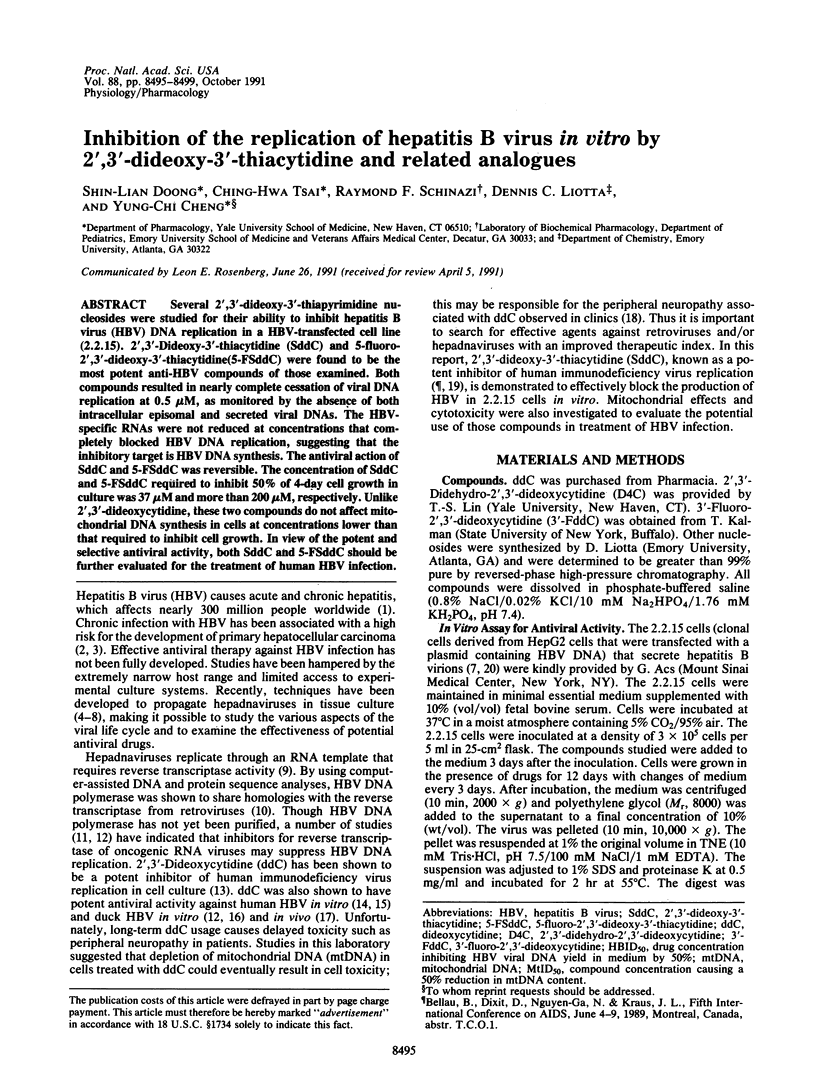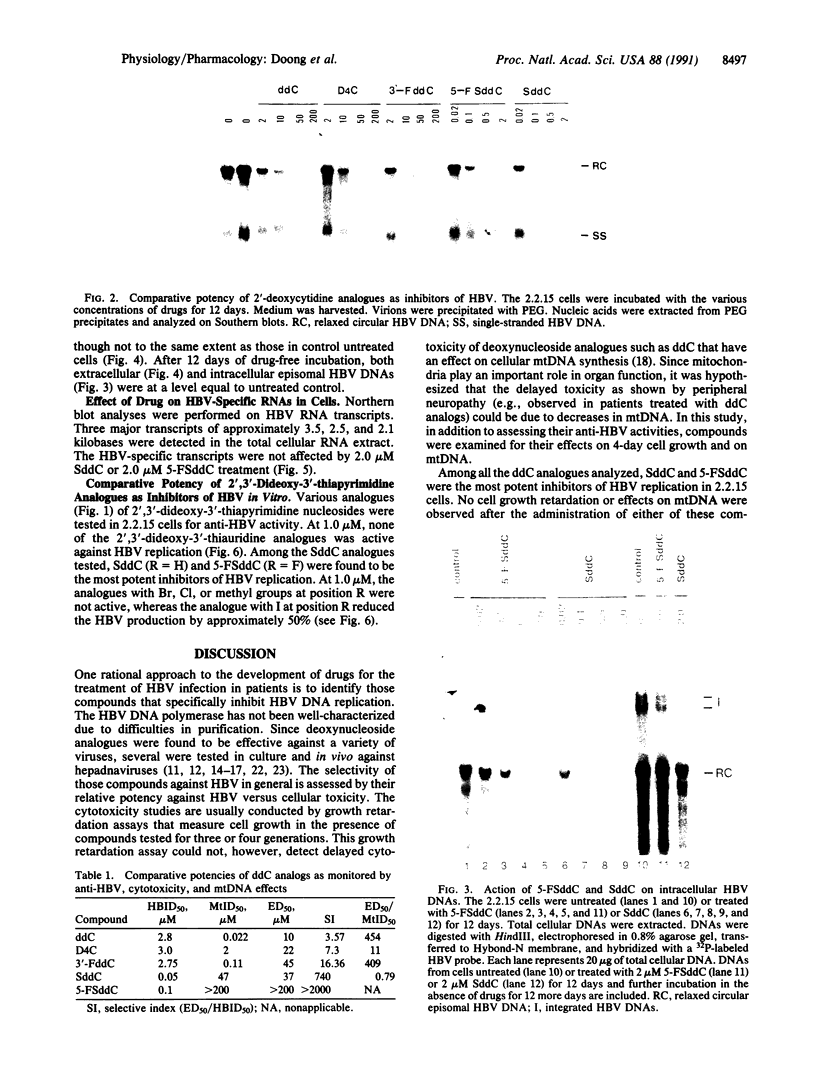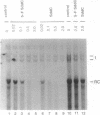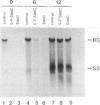Abstract
Several 2',3'-dideoxy-3'-thiapyrimidine nucleosides were studied for their ability to inhibit hepatitis B virus (HBV) DNA replication in a HBV-transfected cell line (2.2.15). 2',3'-Dideoxy-3'-thiacytidine (SddC) and 5-fluoro-2',3'-dideoxy-3'-thiacytidine(5-FSddC) were found to be the most potent anti-HBV compounds of those examined. Both compounds resulted in nearly complete cessation of viral DNA replication at 0.5 microM, as monitored by the absence of both intracellular episomal and secreted viral DNAs. The HBV-specific RNAs were not reduced at concentrations that completely blocked HBV DNA replication, suggesting that the inhibitory target is HBV DNA synthesis. The antiviral action of SddC and 5-FSddC was reversible. The concentration of SddC and 5-FSddC required to inhibit 50% of 4-day cell growth in culture was 37 microM and more than 200 microM, respectively. Unlike 2',3'-dideoxycytidine, these two compounds do not affect mitochondrial DNA synthesis in cells at concentrations lower than that required to inhibit cell growth. In view of the potent and selective antiviral activity, both SddC and 5-FSddC should be further evaluated for the treatment of human HBV infection.
Full text
PDF




Images in this article
Selected References
These references are in PubMed. This may not be the complete list of references from this article.
- Beasley R. P., Hwang L. Y., Lin C. C., Chien C. S. Hepatocellular carcinoma and hepatitis B virus. A prospective study of 22 707 men in Taiwan. Lancet. 1981 Nov 21;2(8256):1129–1133. doi: 10.1016/s0140-6736(81)90585-7. [DOI] [PubMed] [Google Scholar]
- Chang C. M., Jeng K. S., Hu C. P., Lo S. J., Su T. S., Ting L. P., Chou C. K., Han S. H., Pfaff E., Salfeld J. Production of hepatitis B virus in vitro by transient expression of cloned HBV DNA in a hepatoma cell line. EMBO J. 1987 Mar;6(3):675–680. doi: 10.1002/j.1460-2075.1987.tb04807.x. [DOI] [PMC free article] [PubMed] [Google Scholar]
- Chen C. H., Cheng Y. C. Delayed cytotoxicity and selective loss of mitochondrial DNA in cells treated with the anti-human immunodeficiency virus compound 2',3'-dideoxycytidine. J Biol Chem. 1989 Jul 15;264(20):11934–11937. [PubMed] [Google Scholar]
- Chomczynski P., Sacchi N. Single-step method of RNA isolation by acid guanidinium thiocyanate-phenol-chloroform extraction. Anal Biochem. 1987 Apr;162(1):156–159. doi: 10.1006/abio.1987.9999. [DOI] [PubMed] [Google Scholar]
- Di Bisceglie A. M., Rustgi V. K., Hoofnagle J. H., Dusheiko G. M., Lotze M. T. NIH conference. Hepatocellular carcinoma. Ann Intern Med. 1988 Mar;108(3):390–401. doi: 10.7326/0003-4819-108-3-390. [DOI] [PubMed] [Google Scholar]
- Ganem D., Varmus H. E. The molecular biology of the hepatitis B viruses. Annu Rev Biochem. 1987;56:651–693. doi: 10.1146/annurev.bi.56.070187.003251. [DOI] [PubMed] [Google Scholar]
- Kassianides C., Hoofnagle J. H., Miller R. H., Doo E., Ford H., Broder S., Mitsuya H. Inhibition of duck hepatitis B virus replication by 2',3'-dideoxycytidine. A potent inhibitor of reverse transcriptase. Gastroenterology. 1989 Nov;97(5):1275–1280. doi: 10.1016/0016-5085(89)91699-5. [DOI] [PubMed] [Google Scholar]
- Lee B., Luo W. X., Suzuki S., Robins M. J., Tyrrell D. L. In vitro and in vivo comparison of the abilities of purine and pyrimidine 2',3'-dideoxynucleosides to inhibit duck hepadnavirus. Antimicrob Agents Chemother. 1989 Mar;33(3):336–339. doi: 10.1128/aac.33.3.336. [DOI] [PMC free article] [PubMed] [Google Scholar]
- Matthes E., Langen P., von Janta-Lipinski M., Will H., Schröder H. C., Merz H., Weiler B. E., Müller W. E. Potent inhibition of hepatitis B virus production in vitro by modified pyrimidine nucleosides. Antimicrob Agents Chemother. 1990 Oct;34(10):1986–1990. doi: 10.1128/aac.34.10.1986. [DOI] [PMC free article] [PubMed] [Google Scholar]
- Miller R. H., Robinson W. S. Common evolutionary origin of hepatitis B virus and retroviruses. Proc Natl Acad Sci U S A. 1986 Apr;83(8):2531–2535. doi: 10.1073/pnas.83.8.2531. [DOI] [PMC free article] [PubMed] [Google Scholar]
- Mitsuya H., Yarchoan R., Broder S. Molecular targets for AIDS therapy. Science. 1990 Sep 28;249(4976):1533–1544. doi: 10.1126/science.1699273. [DOI] [PubMed] [Google Scholar]
- Price P. M., Banerjee R., Acs G. Inhibition of the replication of hepatitis B virus by the carbocyclic analogue of 2'-deoxyguanosine. Proc Natl Acad Sci U S A. 1989 Nov;86(21):8541–8544. doi: 10.1073/pnas.86.21.8541. [DOI] [PMC free article] [PubMed] [Google Scholar]
- Progress in the control of viral hepatitis: memorandum from a WHO meeting. Bull World Health Organ. 1988;66(4):443–455. [PMC free article] [PubMed] [Google Scholar]
- Rustgi V. K., Hoofnagle J. H., Gerin J. L., Gelmann E. P., Reichert C. M., Cooper J. N., Macher A. M. Hepatitis B virus infection in the acquired immunodeficiency syndrome. Ann Intern Med. 1984 Dec;101(6):795–797. doi: 10.7326/0003-4819-101-6-795. [DOI] [PubMed] [Google Scholar]
- Sells M. A., Chen M. L., Acs G. Production of hepatitis B virus particles in Hep G2 cells transfected with cloned hepatitis B virus DNA. Proc Natl Acad Sci U S A. 1987 Feb;84(4):1005–1009. doi: 10.1073/pnas.84.4.1005. [DOI] [PMC free article] [PubMed] [Google Scholar]
- Sells M. A., Zelent A. Z., Shvartsman M., Acs G. Replicative intermediates of hepatitis B virus in HepG2 cells that produce infectious virions. J Virol. 1988 Aug;62(8):2836–2844. doi: 10.1128/jvi.62.8.2836-2844.1988. [DOI] [PMC free article] [PubMed] [Google Scholar]
- Shih C. H., Li L. S., Roychoudhury S., Ho M. H. In vitro propagation of human hepatitis B virus in a rat hepatoma cell line. Proc Natl Acad Sci U S A. 1989 Aug;86(16):6323–6327. doi: 10.1073/pnas.86.16.6323. [DOI] [PMC free article] [PubMed] [Google Scholar]
- Sureau C., Romet-Lemonne J. L., Mullins J. I., Essex M. Production of hepatitis B virus by a differentiated human hepatoma cell line after transfection with cloned circular HBV DNA. Cell. 1986 Oct 10;47(1):37–47. doi: 10.1016/0092-8674(86)90364-8. [DOI] [PubMed] [Google Scholar]
- Suzuki S., Lee B., Luo W., Tovell D., Robins M. J., Tyrrell D. L. Inhibition of duck hepatitis B virus replication by purine 2',3'-dideoxynucleosides. Biochem Biophys Res Commun. 1988 Nov 15;156(3):1144–1151. doi: 10.1016/s0006-291x(88)80752-6. [DOI] [PubMed] [Google Scholar]
- Tsurimoto T., Fujiyama A., Matsubara K. Stable expression and replication of hepatitis B virus genome in an integrated state in a human hepatoma cell line transfected with the cloned viral DNA. Proc Natl Acad Sci U S A. 1987 Jan;84(2):444–448. doi: 10.1073/pnas.84.2.444. [DOI] [PMC free article] [PubMed] [Google Scholar]
- Ueda K., Tsurimoto T., Nagahata T., Chisaka O., Matsubara K. An in vitro system for screening anti-hepatitis B virus drugs. Virology. 1989 Mar;169(1):213–216. doi: 10.1016/0042-6822(89)90057-3. [DOI] [PubMed] [Google Scholar]
- Yokota T., Konno K., Chonan E., Mochizuki S., Kojima K., Shigeta S., de Clercq E. Comparative activities of several nucleoside analogs against duck hepatitis B virus in vitro. Antimicrob Agents Chemother. 1990 Jul;34(7):1326–1330. doi: 10.1128/aac.34.7.1326. [DOI] [PMC free article] [PubMed] [Google Scholar]
- Yokota T., Mochizuki S., Konno K., Mori S., Shigeta S., De Clercq E. Inhibitory effects of selected antiviral compounds on human hepatitis B virus DNA synthesis. Antimicrob Agents Chemother. 1991 Feb;35(2):394–397. doi: 10.1128/aac.35.2.394. [DOI] [PMC free article] [PubMed] [Google Scholar]







